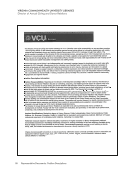5 often takes the form of joint proposals, and is a reflection of a campus culture that encourages cross-unit cooperation in fundraising. Many respondents also report active support from centralized (university- level) development personnel, including support associated with planned giving, prospect identification, stewardship, and annual giving. Evaluating Library Development Staff A wide range of metrics and measures are used in evaluating the performance of chief LDOs. At all but two of the 51 responding institutions, measures of dollars raised, visits, asks/proposals, and overall dollar goals are important or very important evaluation metrics. Measures of gift closures, visits per month or other period, and qualified donors are important or very important factors at all but ten institutions. For about half of these officers, the number of moves, pipeline reports, moves per month or other period, assisting other units, and joint proposals are important or very important for performance evaluation. A comparison of the data collected in this survey to that collected in 2006 suggests some interesting shifts in the measures that are considered important or very important for evaluating chief LDOs. The relative order of the criteria is about the same—with dollars raised at the top of the list both times. In 2006, number of visits, number of asks, and overall dollar goal were the second, third, and fourth most important criteria. In 2018, they share second place and more than twice as many respondents identified them as important or very important. Gift closures and visits per month rose from fifth and sixth place to third and fourth place and almost three times as many respondents rated them as important or very important. All the other criteria were also more frequently rated important or very important in 2018, indicating a broader range of evaluation criteria now. Most frequently, the evaluation of the chief LDOs is conducted jointly by the library director and a senior manager in university-level development (22 responses or 43%). At an equal number of institutions (14 or 28%) only the library director or personnel in the institution’s development office conduct the evaluation. In one case, the dean of the College of Music and the AVC for Advancement conduct the evaluation jointly. Thirty to 40 percent of the 46 respondents indicated a different set of criteria was used to evaluate other library development professionals. Fifteen to 30 percent rated the categories as not important. For the respondents who rated these criteria important or very important, dollars raised and overall dollar goal were the top two evaluation metrics (23 and 20 responses respectively). Number of visits, number of gift closures, and number of qualified donors tied for third place (19 or 41%). A comparison of the data sets for the two SPEC surveys shows that dollars raised stayed at the top of the list while the other criteria shifted positions slightly. About the same number of respondents rated the importance of these criteria in the evaluation of other library development professionals in 2018 and 2006, but the percentage who indicated the criteria are important overall is much higher in 2018. At 71% of the responding institutions the chief LDO conducts the evaluation of the other library development professionals. In two cases the LDO and the library director are joint evaluators. In two other cases, someone from the institution’s development office partners with the LDO. At six institutions management personnel in the institution’s development office conduct the evaluation. At two libraries the library director is the sole evaluator. This frequency is comparable to the level from the data collected in 2006. Evaluating Library Directors Compared to the chief LDOs, the majority of respondents indicated that development outcome and activity metrics and measures are less commonly used in evaluating the performance of library directors. However, dollars raised and overall dollar goal are the top two criteria (40 and 34 responses respectively). Number of visits and number of qualified donors are a distant second tier of performance



















































































































































































